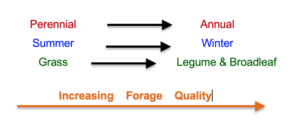Basic Principles of Forage Quality
AgriLife Extension conducts many programs across Texas on different kinds of forages. We all know forage quality is important. My observation is that many hay growers and hay feeders don’t test for it. In fact, at sale I am sure most forage changes hands in Texas with no measurement of forage quality. But forage quality indeed is a value factor. Forage is not just about tons of hay per acre.
A New Mexico State University colleague, research forage agronomist Leonard Lauriault, Tucumcari, shared with me years ago a simple guideline for thinking about forage quality:
Simply, as one moves from a perennial forage to an annual forage the quality of that forage generally increases. This is for many different traits such as reduced lignin, improved digestibility, protein, etc. Likewise, for warm-season vs. cool-season forages and grasses vs. legumes. Of course, growth stage matters as earlier forage harvest is higher quality than later harvest (and should be worth more in the hay market, if buyers recognize this and are willing to pay for it).
Watch Forage FAX for further discussion of various aspects of forage quality and how producers and feeders can benefit from increased information to help you reach your forage goals. For more information on producing quality hay, see the following publication “Producing quality hay .”
This week’s Forage FAX update is provided by Dr. Calvin Trostle, Professor & AgriLife Extension Agronomy, TAMU Soil & Crop Sciences, Lubbock, (806) 723-8432, ctrostle@ag.tamu.edu
